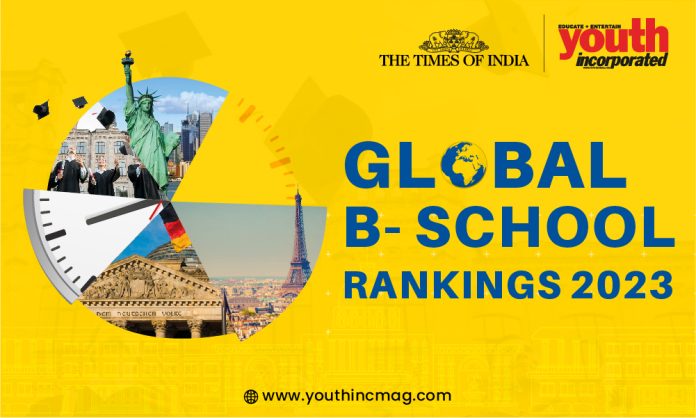In September 2022, jumping from the 11th position, India became the 5th largest economy in the world after the US, China, Japan and Germany, overtaking the UK. There are many key factors behind this growth, a major being its increased exports, especially by penetrating markets earlier monopolized by China.
Now, despite the global recession, India is predicted to become one of the fastest-growing economies in the world for the years 2023-24.
Further, the union budget’s generous allocation of funds towards capital expenditure, infrastructure development, and the need to boost infrastructure financing through private partnership along with other government initiatives, has made the business sector of the country very promising for individuals wanting to enter the business world.
Apart from this, the startup ecosystem has been a key driving force for India’s economic as well as social growth. Currently, India, the third largest tech startup ecosystem, is home to over 27,000 active tech startups.
With such a positive scenario prevailing in the country, it’s hard to resist a tempting and lucrative career in business, finance, management and marketing.
Factoring in the current business environment, many educational institutions across the world have updated their academic curriculum, for equipping students with not just traditional and fundamental concepts but also the modern-day knowledge and skills required to make these fresh graduates industry-ready.
If you are planning to pursue a career in business, finance, management or marketing, it’s important to pick the right educational institution. To help with just that, we at Youth Incorporated have come out with our annual Global B-School Rankings 2023 under which we have compiled the top 100 B-Schools across the globe which are best to graduate from.
Our team connected with 1,820 institutes across the world and held discussions with students, recruiters, and the teaching faculty, to present to you the top 100 Global B-School Rankings. We also consulted professional organizations such as AMBA, EQUIS, and AACSB. Youth Incorporated’s Research Unit (YRU) also studied domestic rankings in various countries to find the best institutes.
The Global Business School Rankings of 2023 have reflected greatly for Stanford University as it has taken the first position rising from the third and the second position in 2022 and 2021 respectively. Maintaining its place from last year is London Business School safely seated in the second position. Unfortunately, Harvard University is down to the third position from its top rank in 2022 as well as 2021. Columbia University too, has retained its 4th position of 2022 this year as well. IESE has climbed to the 5th position, one step upwards from its 6th position in 2022. It has shot up high in 2023 when compared to the 19th position it was in, in 2021. INSEAD is reflecting a downward movement holding the 4th position in 2021, then 5th in 2022 and now the 6th in 2023. From being in 5th place in 2021, IE University slipped down to the 7th position in 2022 and has continued to retain its 7th spot in 2023. The University of Pennsylvania has jumped one step upward to the 8th spot from the 9th in 2022. Cornel University has followed the same trajectory moving to the 9th spot in 2023 from its 10th position in 2022. MIT however has slid to the 10th spot this year from the 8th spot in 2022 and 2021. The Indian Institute of Management (IIM) Ahmedabad has taken a big leap jumping from last year’s 14th spot to the 11th position this year. With this, we can surely expect this Indian institute to make it to the top 10 in 2024.
Speaking about how the Indian Business Schools have fared, we are seeing the Indian Institute of Management (IIM) Ahmedabad make a steady growth securing the 11th position this year after holding the 14th in 2022 and 16th in 2021. IIM Calcutta which held the 18th position in 2021 and rose to the 16th spot in 2022 too has fallen under the top 20 although last year it ranked 16th. Under the top 50 category, apart from IIM Ahmedabad and IIM Calcutta, only the Indian Business School has secured the 35th spot up from the 25th spot in 2022. SP Jain Institute of Management which was on the 48th rank last year also plummeted to the 56th position losing its under-50 tag as well.
With the overall business sector of India undergoing a massive boost, it’s time the India Business Schools rise to the top by 2024.
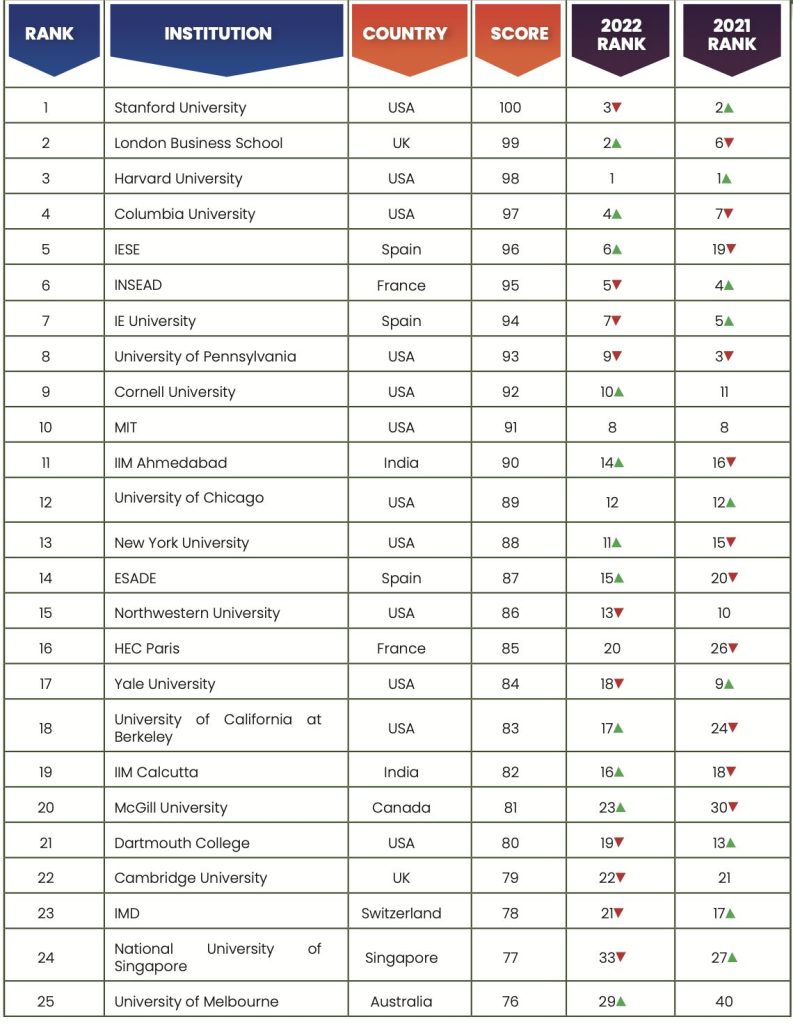
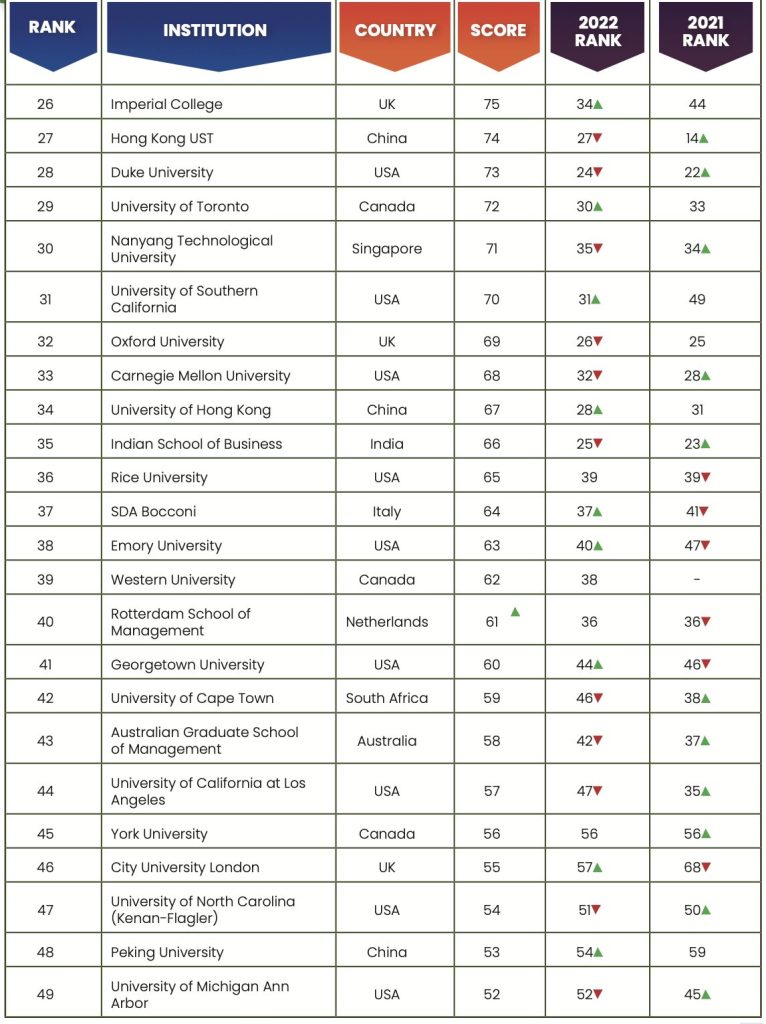
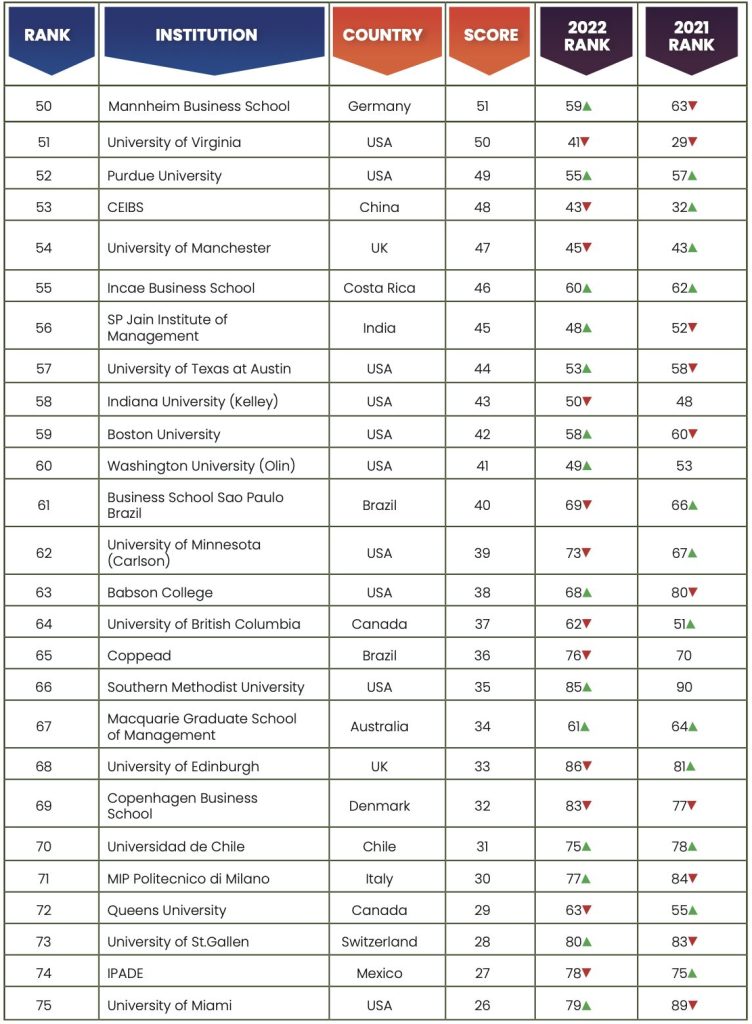
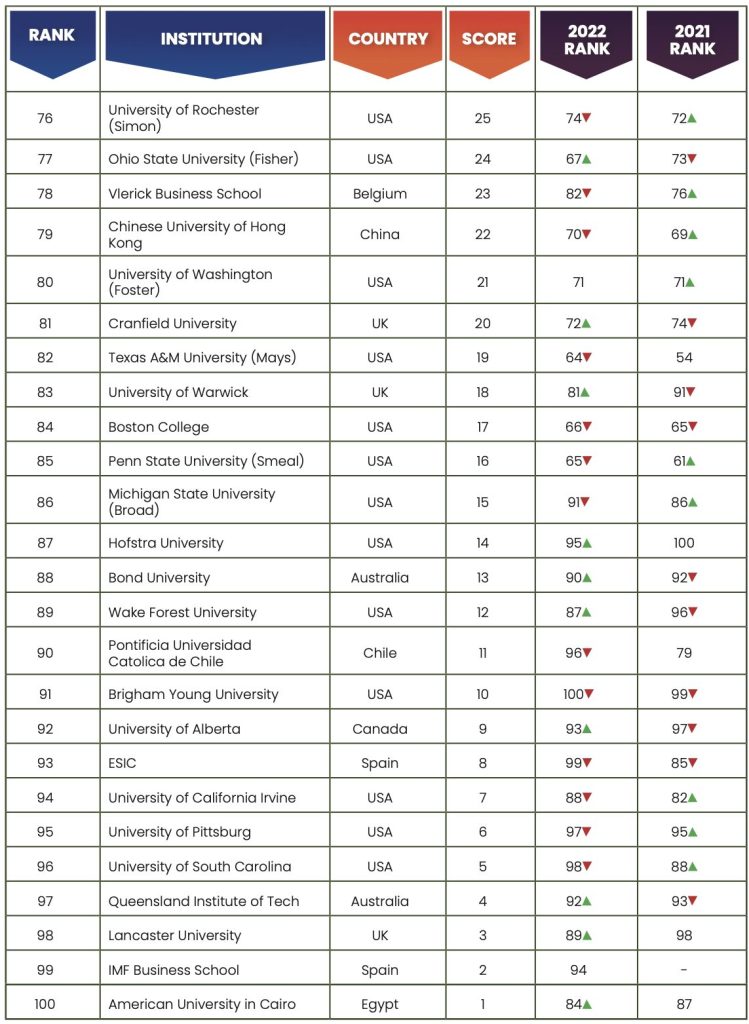
Ranking Methodology
How did we choose institutes?
We chose 1820 institutes across the world after having discussions with students, recruiters and faculty. We also consulted professional organizations such as AMBA, EQUIS and AACSB. Youth Inc’s Research Unit (YRU) also studied domestic rankings in various countries to find the best institutes.
All the institutes were sent identical surveys. We then contacted current students, alumni as well as local and international recruiters and gathered specific information about the institutes.
Factors considered
- Recruiter Perception – Identical surveys were sent to recruiters worldwide. The recruiters were asked to rate the institutes that they were most likely to recruit from. The recruiters were also asked to rate the students they have recruited from specific business schools on several criteria including leadership potential and strategic thinking.
- Diversity of Students – The institutes were asked to report the total number of students on campus and what percentage of the students were international and speak two or more languages. Gender diversity of the students was also considered.
- Diversity of Faculty – The institutes were asked to report the total number of faculty on campus and what percentage of the faculty was international, hold a doctorate degree and accredited with their own publishing material. Gender diversity of faculty was also considered.
- Innovation of Programs – We considered the different ways to construct degree programs as well as the choice students have in terms of selecting electives.
- Innovation in Teaching Methodologies – Institutes were asked to select different teaching methodologies that we considered innovative. Some of these included company visits, dual or multiple majors and course collaborations between different departments at the institute. Our list was selected after surveying students across different campuses worldwide.
- Value for Money – We considered students and alumni opinions on whether a particular institute was perceived as ‘value for money’. We also asked institutes to state the percentage of students who received some sort of funding from the institutes.
- Campus Support – We asked the institutes, current students and alumni to select the different types of assistance provided by the student office or a similar body on campus. Our list was selected after surveying students across different campuses worldwide.
- Career Service – We asked the institutes, current students and alumni about the availability and functioning of a career service cell and how active such a service was for the students. We also considered what percentage of students were actually placed through the institute’s career service cell, how long it look for such placements and what the average starting salaries were.
- Exchange Programs – Institutes were asked to report the percentage of students that opted for exchange programs. We also considered the exchange students present on the institute’s campus.
- Student Satisfaction – Current students and alumni were asked to rate their institutes on various factors including career services, attitude of staff and professors, location, and course content.
Actual Methodology
Institutes were provided a link using which they could send us their completed survey online. They were asked to answer questions relating to full time faculty, career service, student and program information and all the factors listed above.
We contacted current students and alumni of the institutes and asked them to rate specific statements which were pertaining to the factors we considered in this ranking. All the institutes preferred to send the survey links to their students and alumni directly.
Over 16200 recruiters were sent emails with a survey. The recruiter list was prepared from the responses of the institutes and also included internationally well known recruiters. The recruiters were asked to enlist institutes that they were likely to recruit from.
Below is a summary of the factors and the weight-age given to each factor when we ranked the institutes:
| Information reported by the institute | Information reported by current students | Information reported by alumni | |
| Diversity of Students | 2% | 2% | 2% |
| Diversity of Faculty | 2% | 2% | 2% |
| Innovation of Programs | 2% | 2% | 2% |
| Innovation in Teaching Methodologies | 2% | 2% | 2% |
| Value for Money | 2% | 2% | 2% |
| Campus Support | 2% | 2% | 2% |
| Career Service | 4% | 4% | 4% |
| Exchange Programs | 2% | 2% | 2% |
| Student Satisfaction | 2% | 2% | 2% |
| 20% | 20% | 20% |
| Information reported by recruiters | |
| Recall of institute where to recruit from | 10% |
| Likelihood of recruiting from same institute again | 10% |
| Overall satisfaction with students recruited | 10% |
| Satisfaction with institute career cell | 10% |
| 40% |
Each factor was made up of a set of questions. The total percentage attributed to that factor was based on the average score of the responses multiplied by the assigned weight-age. We then totalled the score from all factors and sorted the scores from highest to lowest. The institute with the highest score was ranked 1st.
Not just numbers!
After we received the total computed scores for the institutes, we subjectively analyzed the data provided by the institutes, current students, alumni and recruiters. If we found discrepancies in the satisfaction scores and the subjective descriptions, we omitted the data.
Institutes that did not fill out the survey reports in time
Out of the institutes that were contacted, 141 institutes did not complete the survey on time or did not respond. We used publicly available information on the institutes to include them in our ranking. We also contacted current students, alumni and recruiters of these institutes and compared the data we received with the data from institutes that did participate.
Special notes
Masters in Finance – The programs include the pre-experience as well as the post-experience Masters programs. The ranking also includes the programs which are recently established.
Masters in Management – Certain Masters of Management programs with specializations are also included in the ranking.
Masters in Marketing – Combination courses of Marketing with communication and other fields are also included in the ranking.
Online MBA – Certain factors such as Campus Support and Exchange Programs were omitted in the factors considered for the ranking.
Executive MBA – Certain factors such as Campus Support and Exchange Programs were omitted in the factors considered for the ranking.





















